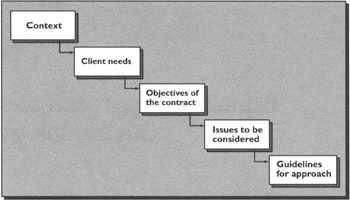Chapter 13: Explaining Approach and Methodology
Shaping the Argument
Fulfilling a contract in a manner that represents value to the client is seldom just a matter of activating systems and applying procedures. Having better systems and procedures than your competitors will never harm your chances of winning a contract, but in most cases it is people who make the difference - their insight into the client's business needs and concerns, the ideas that inform their approach and the energies they bring to the work. These factors give the client the return on its investment in the contract. Don't neglect this aspect of the bid. In writing about your approach and methodology, the task is to show that you understand the objectives and priorities of the contract, are able to respond to them with a businesslike plan of work and can get to the heart of the matter more directly and dependably than any of your competitors.
No contract emerges from the void. It will always be set in a broader context such as a business strategy, a research programme, a development framework, an economic or environmental policy or a response to a difficulty or emergency. This context gives rise to the client's perception of needs and objectives. Meeting these objectives is the purpose of the contract, and this will in turn raise issues and set guidelines for your technical approach. We have here the basis of a simple but useful structure, outlined in Figure 13.1.

Figure 13.1: Example of a Structural Basis for a Technical Approach Section
None of this material should simply repeat the wording of the bid specification, quote back to clients points made in their own documents or offer information about their organization or business that they obviously know already. When clients open your bid, it is your thoughts, your insights they want to find, not theirs! As an example of an effective treatment, Figure 13.2 reproduces the start of the technical approach section of a successful bid.
2 Approach to the study
Our technical approach derives its thrust from four related elements:
the structure of the project;
the economic and social priorities that give the project its justification;
the planning horizon of the project;
the opportunity that the project offers to examine investment policies critical to tourism planning.
2.1 Structure of the project
We have treated the two phases of the study as separate streams of work:
Phase I focuses on the design of an overall plan for the tourism sector;
Phase II is concerned with the basic feasibility of individual projects, and is intended to provide the technical collateral on which the Department can gain funding for necessary improvements in social and physical infrastructure and for initiatives in tourism expansion.
The two phases complement each other and have a mutually supportive part to play in optimizing the benefits of growth. The study has to respond with an approach that is fully alert to the objectives of each phase and that can secure a sound and consistent basis for the attraction of investment. The intended result is a plan of action robust enough to yield practical benefits in the short term and to adapt successfully to the evolving tourism market over the long term.
The impact of the plan will depend as much on the imagination and vision of the agencies that seek to implement it as on the degree of skill and perception which the consultants bring to its formulation. For this reason we attach particular importance to the institutional aspects of the study and to the opportunity for collaboration with the counterpart personnel of the Department and other agencies that have a contributory role in the study.
We have interpreted the institutional analyses as directly related to (i) the requirements of project preparation and implementation, and (ii) the objective of achieving further improvement and diversification in tourism products within the region and a more emphatic participation of local skills in the senior management of one of the nation's major economic sectors. Institutional strength is especially needed in a situation of dynamic growth, where the aim must be to retain command of the development field and ensure the effective coordination of public and private sector initiatives.
2.2 Economic and social priorities
It is the massive contribution of tourism to the regional economy and its unparalleled role as a stimulus to development that make the analysis of inter-sectoral linkages so important within the study. The policy of steering tourism growth to island locations has an obvious part to play in the Department's efforts to improve the balance of development and the distribution of employment opportunities within the region as a whole, reducing the drift of working-age population to the urban centres and relieving the pressures on essential urban services. The planned expansion of tourism offers a greater prospect of integrating island communities within the regional economy and ensuring that they can participate equitably in the benefits of growth.
Figure 13.2: Opening Paragraphs of a Technical Approach Section
If current or recent contracts for the client have given you an in-depth knowledge of its working environment and business objectives, cite this as a factor that can ensure the budget for the work is applied as productively as possible, without incurring the costs of learning curves. If, on the other hand, you are unfamiliar with the detail of the client's business operations, you will need to set out your approach convincingly enough to reassure the client that you can rapidly get up to speed in understanding the context of your work.
EAN: 2147483647
Pages: 145